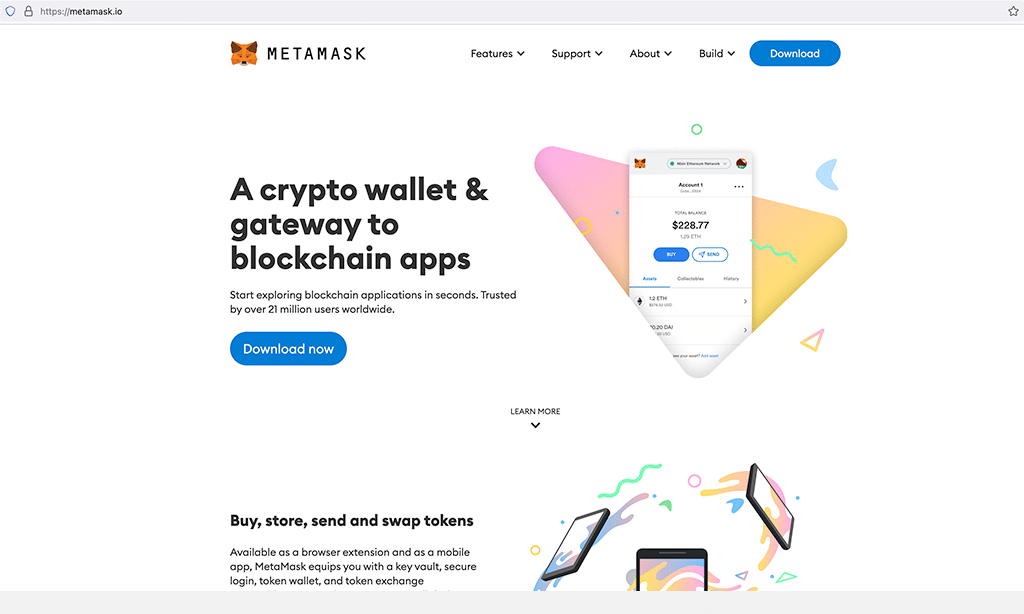Many crypto investors choose to buy and keep their crypto on an exchange such as Coinbase or Binance. This is simple and convenient, but it has some tradeoffs.
For one, investors aren’t in control of their funds. If the exchange is hacked, it could be a big problem. It also limits the number of cryptocurrencies you can buy to what is supported by the exchange. While some exchanges have a wide variety of cryptos to choose from, they never have everything. Investors who stick to exchanges also don’t have the opportunity to make use of DeFi applications, and their NFT investment options are very limited.
What Is a Cryptocurrency Wallet?
To get the most out of crypto, you’ll need to use a crypto ‘wallet’. As the name suggests, wallets are a way to manage cryptocurrency. The wallet doesn’t contain the coins. Instead, the wallet contains a password (called a ‘secret key’) needed to access the funds at a specific cryptocurrency address. Wallets also typically have other features such as the ability to send transactions, check current balances, and sign messages.
Wallets aren’t a new idea — they’re the only way to store cryptocurrency. Exchanges have their own wallets where they store user funds, but users don’t have access to those wallets. If they want to move their coins off the exchange, they must trust the exchange to do it for them.
Today, wallets come in many forms. Some wallets manage a single cryptocurrency like Bitcoin or Ethereum. Others allow you to manage multiple cryptocurrencies at once. Wallets can be software on a computer, an app on a phone, or a physical hardware device.
What Is MetaMask?
MetaMask is one of the most popular wallets for managing Ethereum assets. It is available as both a web browser extension and a mobile app. The browser extension is available for Chrome and other major web browsers, and the app is available on both Android and iPhone (iOS).
MetaMask can send and receive Ethereum and Ethereum tokens, such as Tether (USDT) and Shiba Inu (SHIB). MetaMask allows for easy management of multiple Ethereum addresses within a single interface, providing information about the funds in each address. It also keeps track of any transactions you send or receive. If you need to manage assets on other networks such as Binance Smart Chain or Avalanche, MetaMask can do that, too. Additionally, MetaMask can be connected to a hardware wallet such as Trezor or Ledger for an added layer of security.
MetaMask has Web3 functionality and can connect to crypto-enabled web apps (also called dApps). This allows users to interact with DeFi protocols in a safe and secure manner. For instance, users can use MetaMask to trade assets on protocols such as Uniswap or PancakeSwap. DeFi applications like these allow people to swap cryptocurrencies and tokens without relying on an exchange such as Binance or Coinbase.
In addition to being popular in the DeFi space, MetaMask is one of the most widely supported wallets for NFT trading. Marketplaces like OpenSea and Rarible allow users to trade NFTs with MetaMask. Just like other assets, NFTs can be managed with the MetaMask wallet, meaning you are in control of any NFTs you buy.
To get started with MetaMask, head over to metamask.io to get the browser extension. Alternatively, search for ‘MetaMask’ on Google Play on Android devices, or on the App Store on iOS devices.
Is There Anything Else You Should Know?
MetaMask is a “self-custodial” wallet. This means that you have exclusive access to your funds, instead of relying on a third party such as an exchange. This is a very powerful aspect of crypto because it puts you in control of your money. But it’s also a double-edged sword. If you lose the device your wallet is stored on, you will need your recovery phrase to get access to your wallet again.
Make sure you keep your wallet’s recovery phrase in a safe location, and never share it with anyone. MetaMask provides information on how to properly back up your wallet during the setup process.

